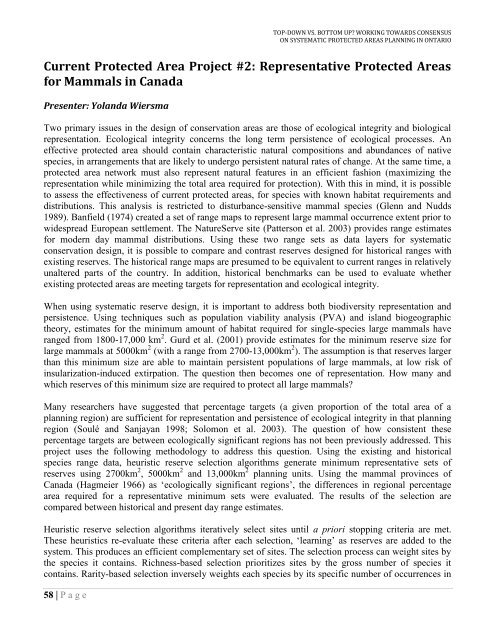Top-Down vs. Bottom Up: Working Towards Consensus ... - CASIOPA
Top-Down vs. Bottom Up: Working Towards Consensus ... - CASIOPA
Top-Down vs. Bottom Up: Working Towards Consensus ... - CASIOPA
- No tags were found...
You also want an ePaper? Increase the reach of your titles
YUMPU automatically turns print PDFs into web optimized ePapers that Google loves.
TOP-DOWN VS. BOTTOM UP? WORKING TOWARDS CONSENSUSON SYSTEMATIC PROTECTED AREAS PLANNING IN ONTARIOCurrent Protected Area Project #2: Representative Protected Areasfor Mammals in CanadaPresenter: Yolanda WiersmaTwo primary issues in the design of conservation areas are those of ecological integrity and biologicalrepresentation. Ecological integrity concerns the long term persistence of ecological processes. Aneffective protected area should contain characteristic natural compositions and abundances of nativespecies, in arrangements that are likely to undergo persistent natural rates of change. At the same time, aprotected area network must also represent natural features in an efficient fashion (maximizing therepresentation while minimizing the total area required for protection). With this in mind, it is possibleto assess the effectiveness of current protected areas, for species with known habitat requirements anddistributions. This analysis is restricted to disturbance-sensitive mammal species (Glenn and Nudds1989). Banfield (1974) created a set of range maps to represent large mammal occurrence extent prior towidespread European settlement. The NatureServe site (Patterson et al. 2003) provides range estimatesfor modern day mammal distributions. Using these two range sets as data layers for systematicconservation design, it is possible to compare and contrast reserves designed for historical ranges withexisting reserves. The historical range maps are presumed to be equivalent to current ranges in relativelyunaltered parts of the country. In addition, historical benchmarks can be used to evaluate whetherexisting protected areas are meeting targets for representation and ecological integrity.When using systematic reserve design, it is important to address both biodiversity representation andpersistence. Using techniques such as population viability analysis (PVA) and island biogeographictheory, estimates for the minimum amount of habitat required for single-species large mammals haveranged from 1800-17,000 km 2 . Gurd et al. (2001) provide estimates for the minimum reserve size forlarge mammals at 5000km 2 (with a range from 2700-13,000km 2 ). The assumption is that reserves largerthan this minimum size are able to maintain persistent populations of large mammals, at low risk ofinsularization-induced extirpation. The question then becomes one of representation. How many andwhich reserves of this minimum size are required to protect all large mammals?Many researchers have suggested that percentage targets (a given proportion of the total area of aplanning region) are sufficient for representation and persistence of ecological integrity in that planningregion (Soulé and Sanjayan 1998; Solomon et al. 2003). The question of how consistent thesepercentage targets are between ecologically significant regions has not been previously addressed. Thisproject uses the following methodology to address this question. Using the existing and historicalspecies range data, heuristic reserve selection algorithms generate minimum representative sets ofreserves using 2700km 2 , 5000km 2 and 13,000km 2 planning units. Using the mammal provinces ofCanada (Hagmeier 1966) as „ecologically significant regions‟, the differences in regional percentagearea required for a representative minimum sets were evaluated. The results of the selection arecompared between historical and present day range estimates.Heuristic reserve selection algorithms iteratively select sites until a priori stopping criteria are met.These heuristics re-evaluate these criteria after each selection, „learning‟ as reserves are added to thesystem. This produces an efficient complementary set of sites. The selection process can weight sites bythe species it contains. Richness-based selection prioritizes sites by the gross number of species itcontains. Rarity-based selection inversely weights each species by its specific number of occurrences in58 | P a g e


